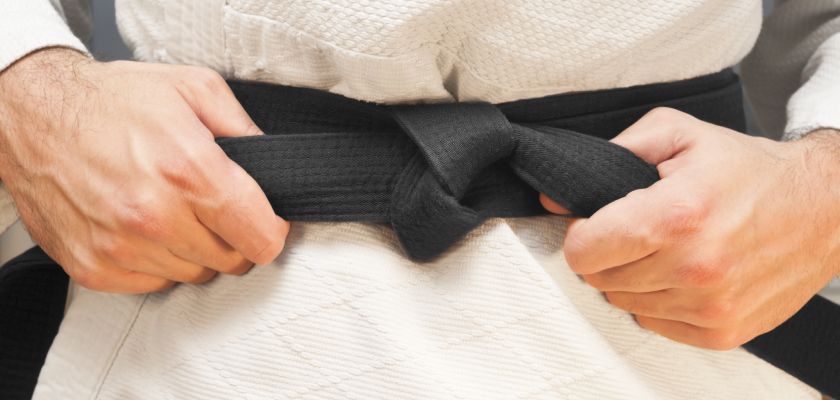Karate is an ancient martial art that originated in Japan and fascinates practitioners of all ages with its disciplinary philosophy and powerful blows. More than a form of self-defense, Karate is a path to physical and mental development, requiring discipline, focus and perseverance. In search of all these elements, mastering the main types of Karate moves is a way for athletes who dedicate themselves to the sport to evolve.
After all, there are an infinite number of variations of strikes, the main ones involving the fundamentals of punches, kicks and elbows.
It’s also important to know how to block and dodge, master the rules of karate and, of course, train until your movements are intuitive during a fight and your decision-making is quicker.
If you play the sport or like to follow fights, you know that taking a second to make a decision can lead to defeat.
That’s why, throughout this article, our intention is to help you take the first step, with a list of the main karate moves, how to execute them and the ideal moments to do so.
Join our free WhatsApp community and receive daily tips, news and trivia on more than 50 sports! Click here to join.
Main karate moves: we’ve listed 24 alternatives for athletes of all levels
On the list of the main karate moves to execute in fights are:
- different types of punches;
- variations of kicks;
- various elbow strikes
- strikes with the hand in the shape of a Sword.
Below we’ve listed the variations in each of these categories of blows and explained how to perform them, so you can vary the execution of your karate routine.
We’ve separated them into groups to make it easier to understand each blow and we’ve also shared some videos to help you understand each movement.
Types of punches
- Age-zuki: punch from below
- Ura-zuki: close punch
- Kagi-zuki: hook punch
- Mawashi-zuki: circle punch
- Awase-zuki: U-shaped double punch
But the list doesn’t stop there, including other types of punches in the list of karate blows such as:
- Heiko-zuki: double parallel punch
- Masami-zuki: double scissor punch
- Yama-zuki: wide U-shaped double punch
There are also some variations of punches, including:
- Gyaku-zuki: reverse punch, when the blow is executed with the opposite arm to the front foot
- Oi-zuki: type of walking punch. The arm that makes the movement corresponds to the foot that has moved forward
- Nagashi-zuki: dodging punch. It is a punch in which the force comes from the movement of the body. Performed from a semi-facing forward position, moving diagonally forwards or backwards.
No, the list of karate punches isn’t over yet! lol
- Kizami-zuki: a blow with the front fist. Without moving the front leg, the punch is applied with the front arm, using the movement of the hips and the back leg to gain momentum
- Morote-zuki: simultaneous punches. In this case, the arms must be parallel, either horizontally or vertically.
Karate blows with the elbow
The list of karate moves that use the elbow to hit the opponent and score points.
Just like the list of punches, karate strikes also have multiple variations, which are very useful at different times in a competition, so it’s important to know them all.
Check them out!
- Mae Hiji-ate: forward elbow strike
- Yoko Hiji-ate: elbow strike to the side
- Ushiro Hiji-ate: backward elbow strike
- Yoko Mawashi Hiji-ate: circular strike with the elbow to the side
- Tate Hiji-ate: upward elbow strike
- Otoshi Hiji-ate: downward elbow strike
Shuto Uchi or blow with the hand in the shape of an espada
This is a list of karate blows that show the flexibility of the sport, using the fist, elbow and hips.
When an athlete executes this type of blow, they generally target the temple, the carotid artery and the sides of the opponent’s body.
For details on how to execute the method, check out the video below.
Keri or leg attack and kick
Like punching, kicking is one of the fundamentals of karate. However, contrary to what people who don’t practice the sport might think, the movement requires more than the use of the feet, but also an efficient and rapid projection of the hips. When this happens, the whole body moves in the direction of the attack.
| Extra care in the Karate kick: when kicking, the athlete must bear in mind that the foot needs to be retracted quickly, so that the opponent cannot grab it and execute the counter-attack. |
Other types of karate kick include:
- Mae-geri: front kick
- Yoko-geri: side kick
- Mawashi-geri: circular kick
- Tobi-geri: jumping kick
It’s worth watching the video and getting to know some of the moves in practice.
In short, the list of the most used karate moves that athletes need to master includes:
- Age-zuki
- Ura-zuki
- Kagi-zuki
- Mawashi-zuki
- Awase-zuki
- Heiko-zuki
- Masami-zuki
- Yama-zuki
- Gyaku-zuki
- Oi-zuki
- Nagashi-zuk
- Kizami-zuki
- Morote-zuki
- Mae Hiji-ate
- Yoko Hiji-ate
- Ushiro Hiji-ate
- Yoko Mawashi Hiji-ate
- Tate Hiji-ate
- Otoshi Hiji-ate
- Strike with sword-shaped hand
- Mae-geri
- Yoko-geri
- Mawashi-geri
- Tobi-geri
Each one has its own execution technique and they all need to be trained to become automatic for the athlete when fighting.
With this, the athlete becomes more flexible and versatile, expanding the range of karate blows they can apply – and surprise – their opponent with.
Join our free Whatsapp community and receive daily tips, news and trivia on more than 50 sports! Click here to join.
And if you’re a sports fan you might also like:
- All about fencing: history, disciplines, rules and more
- The 15 Best Sports Documentaries to Watch
- The 15 Best Sports Series to Watch: Emotion in Every Episode





